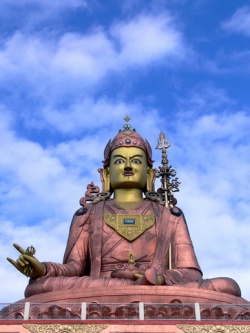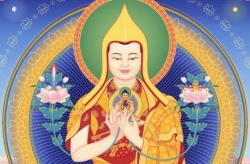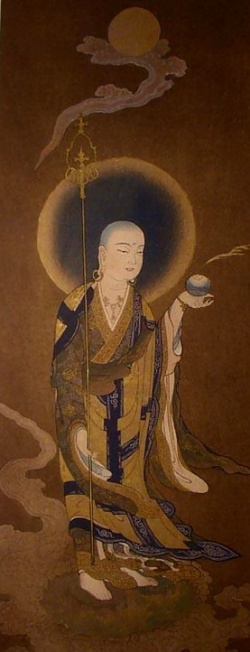Three Roots

The Three Roots (Tib. tsawa sum; Wyl. rtsa ba gsum) are:
In Vajrayana, we talk about the three roots:
(i) Guru: The source of all blessings (ii) Deity: The source of all accomplishments (iii) Protector: The source of all activities.
In Vajrayana, it is necessary to have the three roots.
Without the three roots, you cannot talk about Vajrayana practice.
"[They are] the inner refuge of the Secret Mantrayana.
They are like the root or the basis for all the positive accumulations until you attain enlightenment."[1]
According to the Vajrayana,
As it says in the Longchen Nyingtik Ngöndro Refuge:
Three Roots Practices
In the Nyingma tradition, once we have accomplished the ngöndro, we continue on the path with the sadhanas of the ‘Three Roots’, which are:
- the practice of the lama, which is the root of all blessings,
- the practice of the yidam, which is the root of attainment, or accomplishment,
- the practice of the dakini (Tib. khandro), which is the root of inspiration or activity.
For Rigpa students, the focus for the Three Roots practice is:
- the lama practice of Rigdzin Düpa;
- the yidam practice of Yang Nying Pudri; and
- the dakini practice of Yumka Dechen Gyalmo.
Whilst Rigdzin Düpa and Yumka Dechen Gyalmo are from the Longchen Nyingtik tradition, Yang Nying Pudri is a terma revealed by Tertön Sogyal (1856-1927), the predecessor of Sogyal Rinpoche.
Footnotes
- ↑ Chökyi Drakpa, A Torch for the Path to Omniscience
- ↑ For further explanations on how the Three Roots are in reality the Three Jewels, see Yukhok Chatralwa Chöying Rangdrol, Taking Refuge in his Ngöndro Compendium, and Khenpo Ngawang Palzang, A Guide to the Words of My Perfect Teacher (Boston: Shambhala, 2004), pages 122-123.
Source
The Three Roots (Tibetan: Tsa sum) of the Tibetan Buddhist tradition are the Lama (Sanskrit: Guru), yidam (Sanskrit: ishtadevata) and protector, which may be a khandroma (Sanskrit: Dakini) or chokyong (Sanskrit: Dharmapala).
The Three Roots are the second of three Tibetan Buddhist refuge formulations, the Outer, Inner and Secret forms of the Three Jewels.
The 'Outer' form is the 'Triple Gem', (Sanskrit:Triratna), the 'Inner' is the Three Roots and the 'Secret' form is the 'Three Bodies' or Trikaya of a Buddha.
These alternative Refuge formulations are employed by those undertaking Deity Yoga and other tantric practices within the Tibetan Buddhist Vajrayana tradition as a means of recognizing the universality of Buddha nature.
The Three Roots are commonly mentioned in the Nyingma and Kagyu literature of Tibetan Buddhism.
Unlike most aspects of Tibetan Buddhism, which originated in India, the Three Roots may be an original Tibetan formulation from the time of Padmasambhava.
The functions of the Three Roots are:
- the Lama is the 'root of blessing' or 'root of grace'.
- the Yidam is the 'root of methods' or 'root of accomplishments'
- the Khandroma or Chokyong is the 'root of protection' or 'root of activity'
In the Yangzab compilation of Dzogchen texts the 'Yangzab Three Roots' is the primary Deity Yoga practice.
The Three Roots in this cycle are:
Guru Rinpoche (the Guru),
Hayagriva (the yidam), and
Vajravarahi (the Dakini).
This empowerment is required for the practitioner to study the Yangzab Treasure teaching cycle. The three roots are symbolized in the Gankyil.
Correspondences
Dilgo Khyentse, head of the Nyingma school of Tibetan Buddhism until his death in 1991, explained The Twilight Language correspondences and polyvalent meaning of the Outer, Inner and Secret aspects of the Three Jewels:
The outer Three Jewels are The Buddha, Dharma, and Sangha.
The Three Jewels have an inner aspect, known as the Three Roots:
the Guru (or Teacher), who is the root of blessings; the Yidam, who is the root of accomplishment; and the Dakini, who is the root of enlightened activity.
Although the names are different, these three do not in any way differ from the Three Jewels.
The Guru is the Budha [sic], the Yidam is the Dharma, and the Dakinis and Protectors are The Sangha.
And on the innermost level,
the Dharmakaya is The Buddha, the Sambhogakaya is the Dharma, and the Nirmanakaya is The Sangha.
|
<font=5>Tibetan Buddhist Refuge Formulations
| |||
|
Outer or 'Three Jewels' |
| ||
|
Inner or 'Three Roots' |
| ||
|
| |||
|
| |||
|
blue hum |
white om | ||
The Three Roots formulation also fits into the framework of the Three Vajras of a Buddha where they are seen as equating to the following forms:
the protector is the Body, the Yidam is the Speech and the Guru is the Mind.
According to the Handbook of Tibetan Buddhist Symbols:
"The trinity of body, speech, and mind are known as the three gates, three receptacles or Three Vajras, and correspond to the western religious concept of righteous thought (mind), word (speech), and deed (body).
The Three Vajras also correspond to The Three Kayas, with the aspect of body located at
the crown (nirmanakaya), the aspect of speech at the throat (sambhogakaya), and the aspect of mind at the heart (Dharmakaya)."
Pabongka Rinpoche identifies the seed syllables corresponding to the Three Vajras as: a white om (enlightened body), a red ah (enlightened speech) and a blue hum (enlightened mind).
The individual 'roots'
Lama
In the Theravada Buddhist tradition, the teacher is a valued and honoured mentor worthy of great respect and a source of inspiration on the path to Enlightenment.
In the Tibetan tradition, however, the teacher is viewed as the very root of spiritual realization and the basis of the entire path.
Without the teacher, it is asserted, there can be no experience or insight. The Guru is seen as Buddha.
In Tibetan texts, emphasis is placed upon praising the virtues of the Guru. Tantric teachings include generating visualisations of the Guru and making offerings praising the Guru.
The Guru becomes known as the vajra (literally "diamond") Guru, the one who is the source of initiation into the tantric deity.
The disciple is asked to enter into a series of vows and commitments that ensure the maintenance of the spiritual link with the understanding that to break this link is a serious downfall.
In Vajrayana (tantric Buddhism) as the Guru is perceived as the way itself.
The Guru is not an individual who initiates a person, but the person's own Buddha-nature reflected in the personality of the Guru.
In return, the disciple is expected to shows great devotion to the Guru, who they regard as a Bodhisattva.
A Guru is one who has not only mastered the words of the tradition, but who has an intense personal relationship with the student;
thus, devotion is the proper attitude toward the Guru.
The Dalai Lama, speaking of the importance of the Guru, said: "Rely on the teachings to evaluate a Guru: Do not have blind faith, but also no blind criticism."
He also observed that the term 'living Buddha' is a translation of the Chinese words huo fuo.
The Guru, who in Tibetan Buddhism is generally the Lama, is considered to be the most important of the 'Three Roots' since the Guru embodies enlightened mind and without their personal guidance, the student cannot progress.
"The living teacher proclaims to the student through his or her very existence that awakening is not only possible but immediate for every living being".
Through Guru yoga practices, the Vajrayana student becomes familiar with the Refuge tree and lineage within which the Guru is teaching.
The 'root Guru', or tsawe Lama, with whom the student has a personal relationship, is visualised at the root of the tree, channeling the blessings of all the branches of the Refuge tree to the student.
The blessings are accessed through the practitioner's devotion.
Yidam
The second root is the meditational deity or yidam.
The iconography of the yidam may be 'peaceful', 'wrathful' (Tibetan tro wa) or 'neither peaceful or wrathful'(Tibetan: shi ma tro), depending on the practitioner's own nature.
The yidam represents awakening, so its appearance reflects whatever is required by the practitioner to awaken.
The Guru guides the student to the yidam appropriate for them, then gives them initiation into the mandala of the yidam.
In essence, the mind of the Guru and the yidam are one.
The yidam is considered to be the root of success in the practice.
Protector
The third root is the protector, the root of action or the enlightened activity of realized beings.
In the case of the Nyingma school of Tibetan Buddhism the protector is the Dakini in the other, 'Sarma', schools the Protectors may be a Dakini, a Dharmapala or other Buddhist enlightened beings.
In the Nyingma, the Dakini is guardian of the secret oral, or 'whispered ear tradition and so always serves as the third root.
In the other Tibetan Buddhist schools, the 'Sarma' schools, there are many different forms of protector.
The protector in these schools may be a Dakini or any of a variety of oath-bound spirits, subdued by tantric yogi or yogini.
Judith Simmer-Brown points out that:
The Dakini, in various guises, serves as each of the Three Roots, and may be a human Guru, a vajra master who transmits the Vajrayana teachings to her disciples and joins them in Samaya commitments.The Wisdom Dakini may be a yidam, a meditational deity; female deity yogas such as Vajrayogini are common in Tibetan Buddhism.
Or, the Dakini may be a protector; the Wisdom Dakinis have special Power and responsibility to protect the integrity of oral transmissions.
Source
The three evil roots, i.e.
Another group is the three grades of good "roots" or abilities, i.e. superior, medium and inferior.



